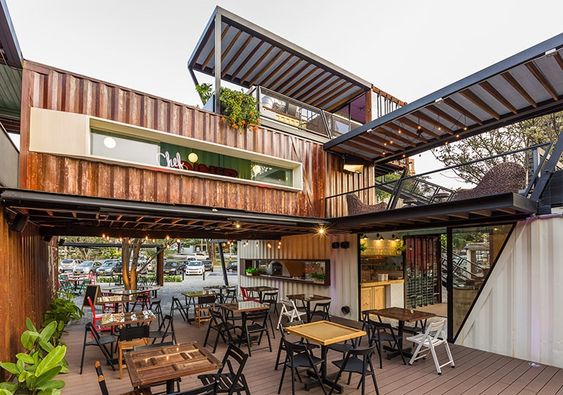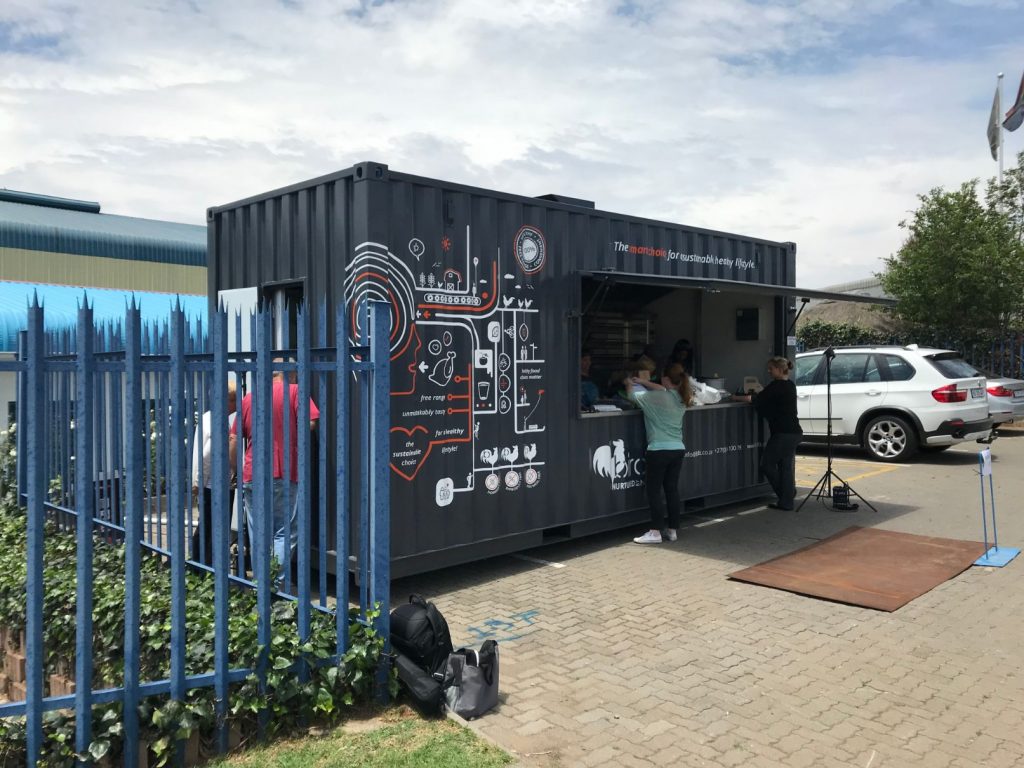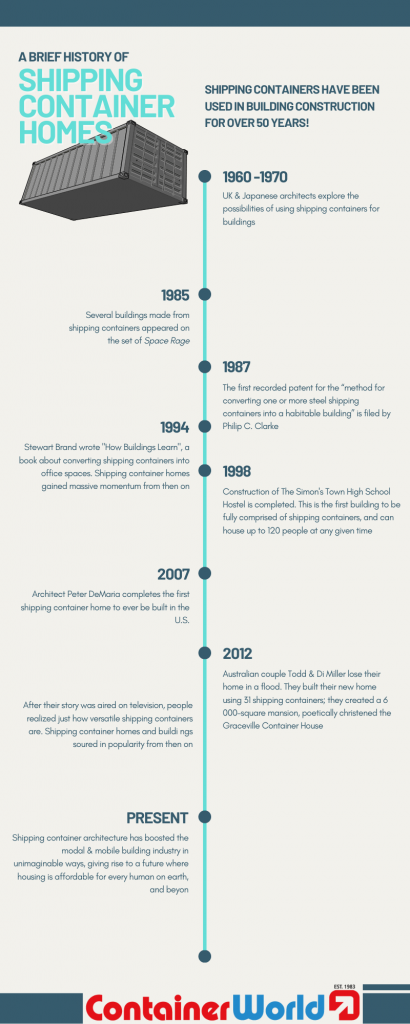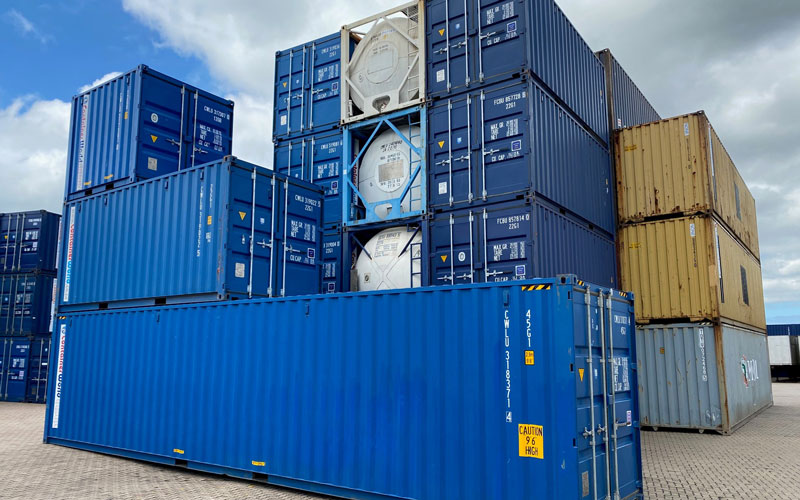Ultimate Guide to Shipping Containers
9 Innovative Ways You Can Use ISO Containers
Every now and then, an invention comes along that completely changes the world.
From the lightbulb to the assembly line, these inventions have shaped our modern world in fundamental ways.
When it comes to logistics, global trade, freighting, and the general transportation of goods, nothing comes as close to revolutionary as the shipping container.
Known formally as the intermodal container or ISO Container, this simple invention has over the years boosted productivity and improved cash flow for several global trades and industries.
The reason is pretty simple, let’s take a trip back in time to find out.
The History of Shipping Containers
Before the dawn of the 20th century, long-distance transportation of goods and other items was a truly hellish experience.
People relied on crates, sacks, and barrels to get their goods overseas and overland.
These were known as breakbulk cargo: goods that were stored onboard cargo ships as individual units.
This meant that workers had to load these items one-by-one – by hand – onto their assigned cargo ships.
As you’d imagine, this took several days and a few broken backs to complete.
Added to that excruciating experience was the necessity for railway freighting; it would take up to a week for workers to offload goods from cargo ships and onto their designated train cars.
This was bad for business, not because workers were breaking their backs, but because the time it took to load and offload these goods translated to ridiculously high operational costs.
While primitive versions of the shipping container were invented as early as the 18th century, they wouldn’t become the all-in-one transport and storage solutions we’re used to today.
The rise of the shipping container (containerisation) started out in the coal mining regions of England during the latter half of the 1700s.
James Brindley designed a box boat which he christened the Starvationer – an invention that would later be popularised as the Narrow Boat.

Modern narrowboats for leisure cruising, Bugsworth Basin, Buxworth, Derbyshire, England. Source: Wikipedia
Containerisation: The Rise of Intermodal Freighting
Fast-forwarding a couple of centuries, shipping containers evolved quite glacially.
It wasn’t until the end of the first World War that shipping container technology started its rapid advancement.
Between 1920 and 1950, several advancements were made, all of which led to Containerisation – an era that saw the rapid development of standardized shipping containers.
Even though shipping containers have a long and rich history, the modern intermodal container system wasn’t developed until the mid-1950s.
Malcolm McLean, a giant in logistics, developed an early version of the modern shipping container we’re used to.

Malcolm Mclean, the father of Shipping Containers. Source: JPGreene
At the time, McLean needed a container that could effectively be loaded onto ships and hold down securely during voyages of any distance.
He worked with Keith Tantlinger, a gifted mechanical engineer and inventor, to design and construct a container that was 2.44 m in width and height, 10.5 m in length, and was made entirely from 2.55 mm thick corrugated steel.

Keith Tantlinger, a major role player in modern containerisation. Source: Wikipedia.
These containers were installed with twistlock mechanisms atop each of their four corners, a feature that made it easy for the containers to be secured in place, as well as lifted and transported using cranes.
After the initial success of this container system, Tantlinger convinced McLean to give their patented designs to the global logistics industry, thus beginning the standardization of shipping containers.
Ever since then, the world hasn’t looked back – for good reason too.
Today, shipping containers are used for more than just storing and transporting goods.
From container self-storage to modal housing, the applications of intermodal containers in today’s world are vast.
In the next few sections, we’ll explore some of the common, most effective applications of shipping containers.
Whether you’re interested in a history lesson or a comprehensive quote for shipping containers, we’ve got you covered. Fill out the form below to get started!
Let us know what you need
The first application of shipping containers we’ll be exploring is a bit of a package deal.
Ranging from swimming pools and playground props to mobile offices and ablution units, shipping containers can be converted into many different and useful things.
Let’s take a look at a few of them:
1. Swimming Pools

A stunning, modern shipping container swimming pool. Source: Pinterest
Most homeowners want swimming pools, but not everyone can afford one – not the traditional concrete or fibreglass ones anyway.
Inflatable pools are decent substitutes, but they damage easily and are often not worth the long-term investment.
Shipping containers are the perfect alternatives when you can’t install a proper pool in your yard, or if you just want more DIY control over your swimming pool.
They offer strength, durability, and reliability – not to mention they’re much more affordable than fibreglass or concrete swimming pools.
The concept is simple: you can use a shipping container as the shell for your pool without having to lay down any concrete.
You can dig a hole in your garden and install the container, or you can opt to create an above-ground pool that complements your home’s design.
Shipping containers make for the perfect pool shells. They’re fully sealed, waterproof systems that can handle any amount of water.
Connecting a container to a working pool circulation system, standard with a pump, drain, and filtering system won’t be much of a problem once you’ve laid down the foundational structure.
Container World specialists can convert shipping containers into just about any type of modified unit - you think it, we make it.
Get in touch with one of our specialists today if you’d like to get a personalized container solution.
2. Storage Containers for the Retail and Food Industries

A stylish & rustic restaurant using shipping containers as main structures. Source: Pinterest
From time to time, we get asked a few questions we think need answering:
“Can I turn a shipping container into a restaurant?”…
…or “can I use a shipping container for my shop?”…The simple answer is YES, you can.

Shipping containers, when converted to your spec, can be used for virtually anything that a concrete building can be used for.
From storing your goods and items to displaying them to potential customers as a makeshift store, you have a lot to work with when converting your shipping container into a store or restaurant.
Whatever it is that you’re selling, using a shipping container as your establishment’s main facility can save you a lot of time, money, and headache.
Just as any permanent building, you’d first need certain permissions, as well as maintain compliance with safety regulations to use a converted container for your establishment.
No worries though; if you hire an accredited architect, they’ll help you get all your documents in order.
If you’d like a little more motivation, check out these 6 benefits of using shipping containers for your establishment.

Container World Converted Food Truck Container
3. Container Homes & Architecture
Over the last decade, shipping containers have revolutionized the housing and construction industries beyond measure.
The concept of using shipping containers for building construction has been around since the 1960s; the practice though has only recently reached new heights in an ever-increasing upward trend.
Otherwise, here’s a timeline depicting the history and rise of shipping container homes.

Are you keen on another history lesson? Skip down to the history of shipping container homes by clicking here.
Container homes continue to be used today in most parts of the world. As both functional and decorative buildings, shipping containers – as simple as they are in concept – have acted as a foundational innovation in the rise of modal housing and architecture.
Container World specialists can convert shipping containers into just about any type of modified unit - you think it, we make it.
Get in touch with one of our specialists today if you’d like to get a personalized container solution.
4. Reefers: An Era of Refrigerated Container Units
Over the last 150 years, reefers have allowed people to store and transport frozen & refrigerated goods over short and long distances.
Having made their debut in the latter half of the 19th century, reefers started out as ships that were fitted with refrigeration units; the first-ever reefer voyage was attempted in 1876 when the Northam sailed from Australia to the United Kingdom.
This first attempt resulted in failure when the refrigeration machinery broke down and cargo was lost; this however didn’t stop innovators around the world from developing the technology.
Throughout the late 1800s, reefer ships evolved and went from strength to strength, giving rise to the invaluable trade of transporting and storing refrigerated goods.
In 1935, an engineer by the name of Frederick McKinley Jones invented the first portable air-cooling unit; and with this innovation began the era of refrigerated container units.
Fast-forwarding to the present day, reefers have opened doors for so many people and businesses alike.
Refrigerated container units are now the most popular pieces of equipment for people who need cold storage, as well as for those who need efficient freeze-blasting machinery.
Whether you’re an event manager or a butchery owner, refrigerated containers can help you save money with all that they offer.
5. Emergency Medical Facilities
Shipping containers can be converted into several kinds of temporary, makeshift medical facilities for any kind of emergency.
Disaster can strike at any time; having the option of converting shipping containers into mobile clinics, treatment centres, and emergency response camps can mean the difference between life and death – especially in less developed countries.
Our COVIDtainers are the perfect example of how shipping containers can be used to set up makeshift clinics and medical facilities.
This turnkey solution gives you access to mobile container units that can be easily customised to meet your needs.
Whether you need a testing centre of a popup vaccination site, our COVIDtainers are the ideal solution to help combat the coronavirus.
Watch the video below to learn more!
Container World specialists can convert shipping containers into just about any type of modified unit - you think it, we make it.
Get in touch with one of our specialists today if you’d like to get a personalized container solution.
Self-storage has been around for centuries now, having its origins in ancient Asia and – more recently – in the United States.
Today, the self-storage industry is worth over $40 billion, and it’s only going to get better.
We won’t get too much into the history of self-storage; if you’re interested to read all about it though, click here.
Otherwise, let’s talk about how shipping containers have changed the self-storage business for the better.

Container World self-storage units, reefers, and tanktainers.
Between the 1950s and 1960s, shipping containers became the gold standard for maritime and overland transportation.
People started to realise that these containers could be used for storage just as well as they were being used for shipping and the transportation of goods.
With this realisation began a trend that continues to grow today: the reliance on shipping containers for self-storage.
While there isn’t a clearly recorded history of how shipping containers came to be used in the self-storage industry, we do know for certain that they’ve been contributing to the growth of the self-storage business for the better part of 3 years now.
Alright. Now that we’ve taken care of the formalities, let’s get into a few reasons why shipping containers are better than brick & mortar units for self-storage.
Are Shipping Containers The Best Choice for Self-Storage?
The answer is of course a resounding YES!!, but many people may not know the exact reasons why shipping containers are the best option for self-storage.
In a nutshell, they save you a decent amount of money while offering a level of convenience you won’t get with brick & mortar self-storage units – let’s get into it.
3 Benefits of Using Shipping Containers for Self-storage
This one benefit alone adds several more advantageous factors to using containers for self-storage. For example; here at Container World, we’ve managed to strategically place our facilities in major urban centers to cater to more people.
Because we use container storage rather than brick and mortar buildings, we’re able to accomplish this with relative ease and allow for more people to reap the benefits of self-storage at very affordable prices.
Shipping containers offer just as much – or not, more – security as brick and mortar self-storage facilities. Containers, as simple as their designs may seem, can be harder to break into than a brick and mortar storage unit.
So, what you basically get is a secure self-storage unit, located conveniently in your area, with a storage fee that won’t ever break the bank.
What more could you ask for?
If it’s your first time having to rely on a third party to help store your stuff, you may not consider cleanliness right from the get-go.
In most cases, brick and mortar storage units are more likely to let in a load of undesired contaminants. Whether it be dust or bugs, traditional self-storage units have far more openings than shipping containers that allow in dirt.
For shipping containers, this is by design – think about it. These containers were designed to be out at sea, on the road, or in stationary storage for months to years on end.
They’re designed to keep out contaminants and corrosive substances to properly preserve the goods within.
This can work to your advantage when you need a reliable self-storage solution; the best part is that you’ll most likely spend less on shipping container self-storage than you would on brick and mortar storage units.
Sounds good to you? Click Here to get the ball rolling!
Brick and mortar self-storage facilities are usually limited in the number of storage units they can host. Expansion usually means tedious construction efforts that could affect your access to your storage unit.
With shipping containers though, expansion is as easy as adding a fresh stack of containers on an open plot of land. It’s virtually hassle-free and can be done within hours.
What does this mean for you? Well, if you ever find yourself having more items that need storage than we have the capacity for, it’s always possible to arrange additional storage space by bringing in a few more storage containers to cater to your needs.
All you’d have to do is get the conversation going – we’re always prepared to be as flexible and adaptable as possible for our clients.
For the curious cats – how secure are shipping containers really? The short answer is VERY. If you’re keen for the longer answer though, check out this article from SJones Containers!
Container World provides flexible, reliable, and secure self-storage solutions for people in Johannesburg, Polokwane, and Durban. If you’d like to learn more about our affordable self-storage solutions in South Africa, fill out the form below!
Let us know what you need
As we touched on earlier, shipping containers have innovated the way we view housing and construction.
From simple mobile container homes to complex container-based apartment buildings, the possibilities of container-based construction are almost endless.
To get a better understanding of just how much impact shipping containers have had on the housing and construction industries, we’re going to explore the history of shipping container homes and how they’ve become somewhat of a cultural rave.
A Comprehensive History of Shipping Container Homes & Architecture
Now that we’ve got that out of the way, let’s get into the meaty part of things. As we’ve already discussed, shipping containers have been around for centuries.
In the mid-1950s, everything changed when Malcolm McLean and Keith Tatlinger worked together to create what would become the modern-day shipping container.
Their invention was a game changer, not just for global trade and logistics, but for the housing and construction industries as well.
The reason for this is simple: shipping containers are self-supporting units that are designed to be stronger than a typical brick and mortar building.
They require no foundation or load-bearing structures to house.. well… anything.
Shipping containers have been used for homes and buildings since the 1960s, but have only recently gained popularity after a couple built the Graceville Container House after losing their home in a flood.
But, when did the idea of using shipping containers as free-standing buildings surface?
Container Homes Through The Years - From Past to Present
Throughout the 1960s and ‘70s, architects in the U.K. and Japan began exploring the concept of container urbanism, that is, the repurposing of shipping containers to be used for urban architecture.
Explored by the British group Archigram and inspired by Japanese Metabolists, urban architecture would never be the same.
If you want the full scoop of how this architectural revolution began, check out this in-depth feature by the Places Journal.
Architectural Metabolism “was a post-war Japanese architectural movement that fused ideas about architectural megastructures with those of organic biological growth.”
In the decades that followed, the idea of using shipping containers to build homes and other kinds of buildings gained momentum.
Even though they’d already existed for years, the first container home to be officially recorded surfaced in 1987 when Philip C. Clarke filed a patent for the “Method for converting one or more steel shipping containers into a habitable building at a building site”.
In this patent, Clarke covered in-depth how shipping containers could be converted into suitable living quarters, as well as how this concept could be used in several architectural applications.
2 years later, his patent was accepted, and expired in 2007; this was ironic considering how the period between 2007 and 2013 was arguably the most significant time in the history of shipping container homes.

First official patent for shipping container architecture, filed by Arthur C. Clarke
In 1994, Steward Brand wrote How Buildings Learn, a book that spoke about converting shipping containers into office spaces.
This was the first recorded publication that mentioned the idea of converting containers into buildings – the trend began gaining momentum ever since.
Fast-forwarding to recent times, the news of the Graceville Container House spread like wildfire after it was built in 2012 – the world hasn’t looked back since.
Today, there are innumerable homes and buildings that have been built from shipping container units; because of their modal nature, shipping containers have been the main features in the modular building obsession many architects have to this day.
Even though we’re a few decades in with container architecture, this is only the beginning.
Container World offers a broad range of container conversions you can use for homes, office units, establishments, clinics, temporary sites, and several more. If you’re interested in learning more about this, click the button below!
It would be pointless to cover every single application of converted containers in this blog, no matter how many late nights we commit to.
Regardless, we’ve already covered a handful of the best ways you can make the most of shipping containers. Even so, we’re nowhere near the peak.
So, to make things easier, in this section we’ll get into 3 container conversion applications that Container World specialises in: mobile ablution units, mobile camps, and multi-house flatpacks.
When you’re hosting an event or managing a business that’s always on the road, there are so many things you need to organise and arrange for.
One of the most underrated and (sometimes) overlooked factors are ablution stations.
At the end of the day, everybody needs a toilet break. Neglecting this necessity when coordinating an event or managing a temporary office/construction site can make or break your operation.
Think about it this way; if people attending your event:
- Can’t access your toilet for whatever reason;
- Have no toilet to access, or;
- Find the experience of using your toilets as the most disgusting thing ever…
Odds are they’ll think twice about attending your next event. Also, if you fail to procure enough mobile ablution units to cater to hundreds of people, queues will be too long for some people who will eventually do their business in the bushes; in most cases, this can get you and your company in trouble with the authorities.
Catering to hundreds, if not thousands, of people regarding ablution stations can be a tricky task – but it isn’t impossible… Not when you have a supplier like Container World on your side.
When you have a relatively large operation on your hands, one that doesn’t stay in one place forever, you need to have a mobile building solution you can always rely on.
Many businesses have turned to mobile, modular architecture to make traveling with their camps as effortless as possible.
Mobile camps can be constructed from a number of materials and can serve several different purposes.
Primarily, they work perfectly as temporary living and working quarters for different kinds of operations.
Mostly used in the mining and construction industries, container mobile camps are the ideal solution for operations of any size.
Here at Container World, our mobile camps can cater for anywhere between 200 and 3000 workers.
With our container buildings, you’re guaranteed comfortable, practical, safe, and cost-effective container housing solutions that you can always lean on.
We also use our effective prefabricated MultiHouse® products to add as much value as possible to our mobile camps.
The crown jewel of Container World’s offering is the MultiHouse® flat-pack, a modular building solution that combines the strength and durability of shipping containers with the versatility of prefabricated buildings.
Our unique flat-pack product offers several additional benefits on top of everything you get with shipping containers and prefabricated structures:
- You can save on transportation costs. Our flat-packs are readily available for transport to any worksite; they’re packaged in a flat-pack kit and can be easily assembled on-site. All in all, you can save up to 75% on transportation when you opt to use MultiHouse® flat-packs.
- Our MultiHouse® flat-packs are stackable, modular, and dynamic. If you don’t have much space to work with, you can opt for vertical flat-packs. Added onto that, their modular nature allows you to add, subtract, or adjust the units to suit your specific needs.
- Container World MultiHouse® flat-packs come with several interior options you can choose from. They come standard with Chromadek or wooden cladding in varying shades. Whether you choose one or the other, you can easily customise your units to your liking.
MultiHouse® flat-packs offer a high level of fire and wind resistance. All our units are made from non-combustible materials and are sturdy against strong winds. All in all, you won’t ever have to worry about bad weather.
Whether you’re interested in a history lesson or a comprehensive quote for shipping containers, we’ve got you covered. Fill out the form below to get started!












